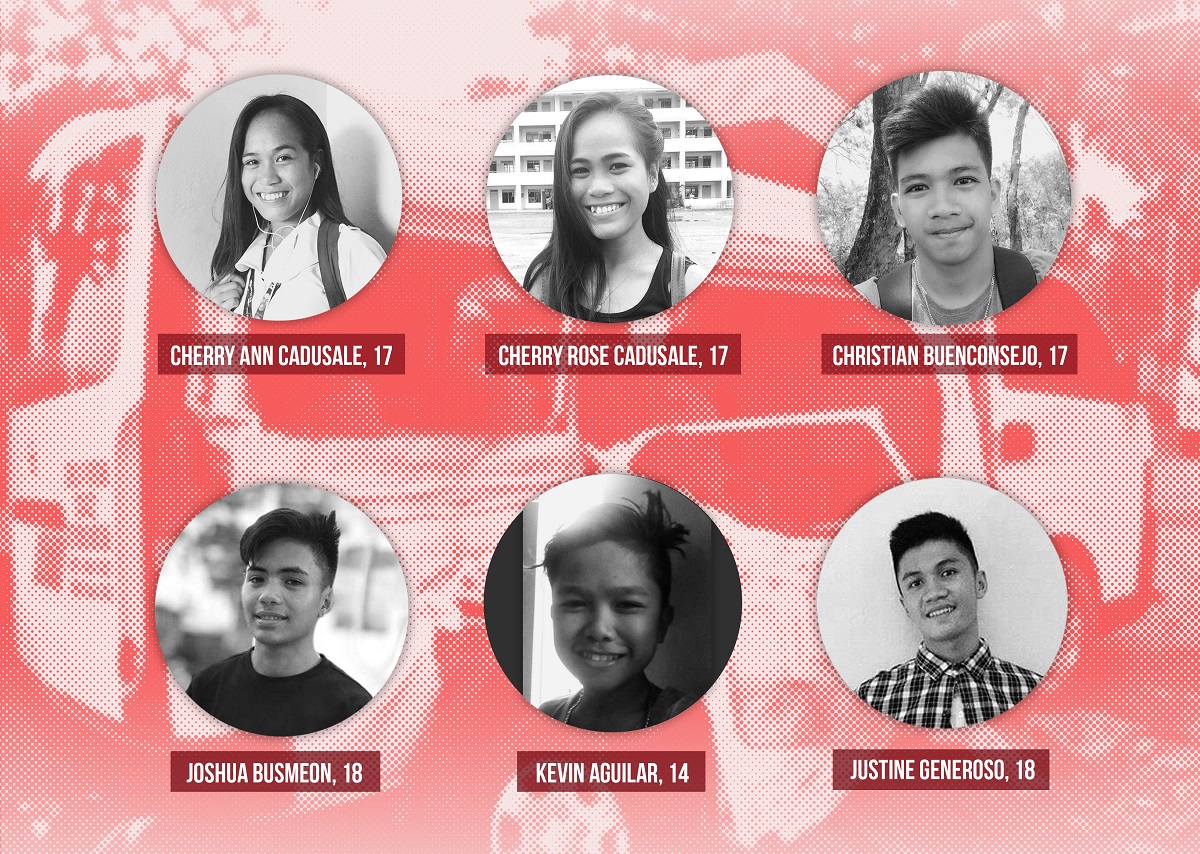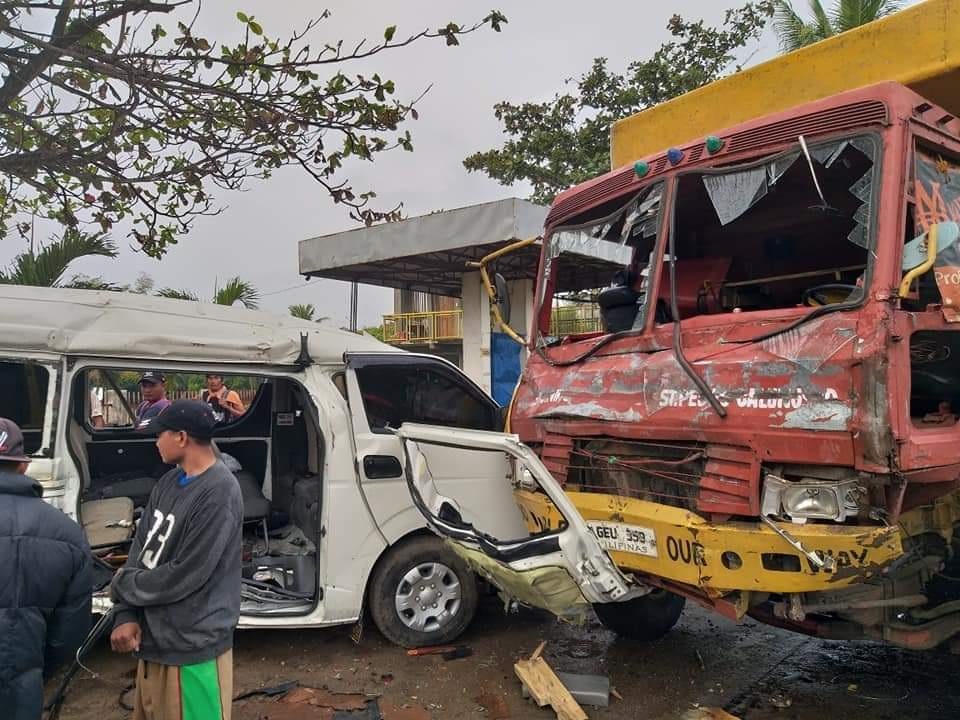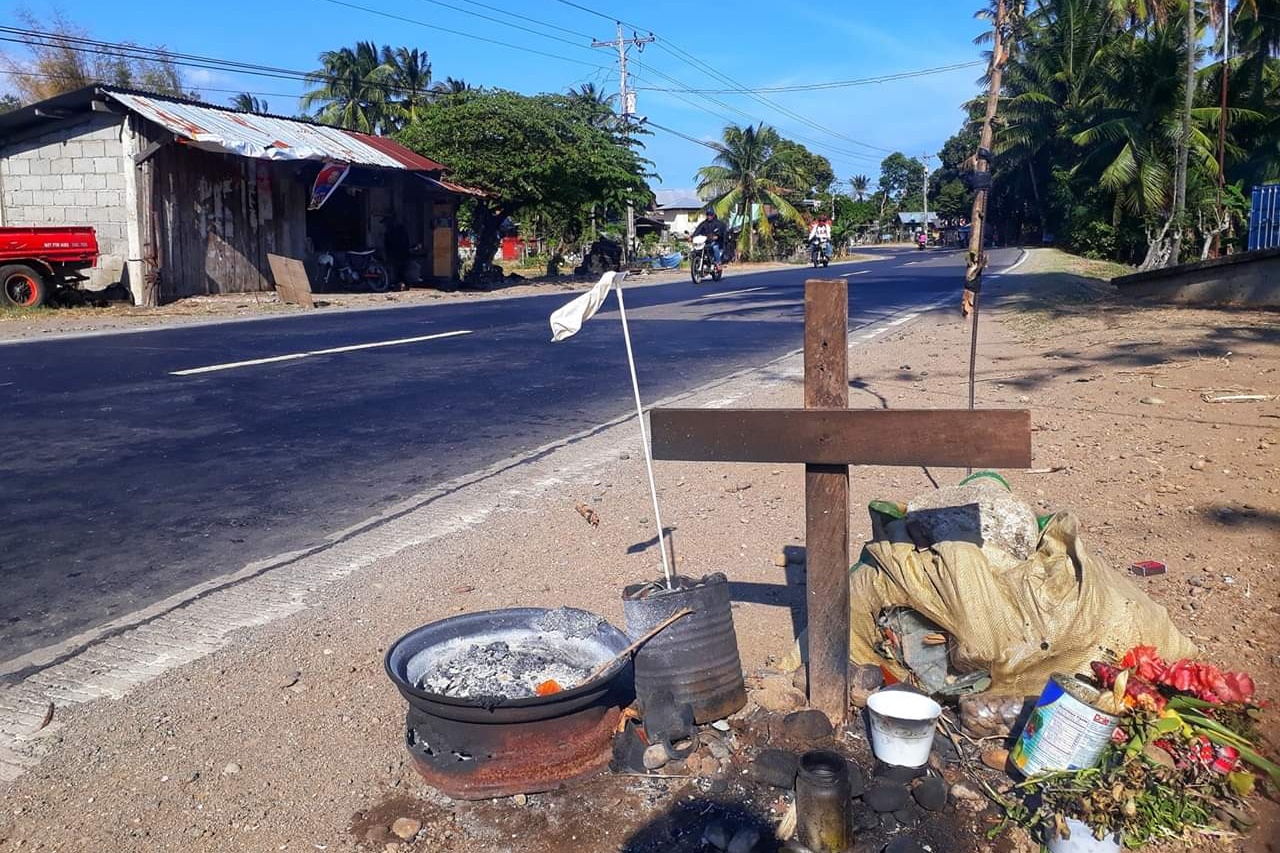We use cookies to ensure you get the best browsing experience. By continued use, you agree to our privacy policy and accept our use of such cookies. For further information, click FIND OUT MORE.
By RAFFY CABRISTANTE
Graphics by Michael Diosim Endab
May 31, 2019
The Basay National High School team competes at the Regional MathSayaw dance competition of the Department of Education on February 28.
“Pauli ta, pauli.”
Let’s go home. Cherry Rose Cadusale, 17, posted these three words on Facebook, mere hours after they left Cebu City on the way to Dumaguete. Along with her twin sister Cherry Ann and their teammates from Basay National High School (BNHS), Cherry Rose more than excited to go home to bring packs of pasalubong and the good news: their team won seventh place in the Regional MathSayaw dance competition of the Department of Education on February 28.
The group was composed of “cream of the crop” of BNHS: Cherry Ann and Cherry Rose, 17; fellow senior high school students Justine Generoso, 18; Jessie Mae Sabanal, 18; Joshua Busmeon, 18; James Bagarinao, 18; Christian Buenconsejo, 17; Elmar Toquero, 17; Willie CJ Chua, 17; and junior high school freshman Kevin Aguilar, 14.
It was the twins’ first time in Cebu, a city much bigger and busier than their quiet hometown of Basay, the southernmost town in Negros Oriental, about 113 kilometers away from Dumaguete City. The trip had been fruitful, despite the challenges.
Their teacher and adviser John Mark Prestin, 26, recalls the major setback they experienced prior to the day of the competition: they accidentally left their props in Basay, so the team spent the entire night making replacement props from scratch.
“I could see the passion in the students. They never complained. They did everything in their control so they could win,” Prestin remembers in a mix of English and Cebuano.

The Basay National High School team pose at the #DumaGeTmE sign before beginning their travel home. John Mark Prestin
A few hours later, the team finally crossed the Tañon Strait to make it from Cebu to Negros Oriental. Cherry Rose posted another update on Facebook: “@Dumaguete.”
It was five in the morning on a Friday, March 1st. It was raining by the time they arrived, but they managed to get together and take a picture in front of the iconic #DumaGetMe sign at the pantawan (sea deck) of Rizal Boulevard. As it turns out, this photo was going to be their last picture together as a team.
The group temporarily split; the first batch led by Generoso, the second led by Prestin. Taking two pedicabs (the Dumaguete term for tricycles), the two groups headed for the van-for-hire (V-hire) terminal in Barangay Calindagan, a few minutes away from the boulevard. Since Generoso’s group already boarded a V-hire and had their props on board, Prestin’s group followed suit and went inside the van.
The van left the terminal at exactly six in the morning. Cherry Rose shared a post on Facebook as they left: “Can I receive an ‘I love you’ for no reason?”
About 30 minutes into the trip, the southbound van was plying the national highway along Barangay Mayabon in Zamboanguita town, 20 kilometers south of Dumaguete, when it suddenly started swerving, reportedly due to the slippery road brought by the rain. Not too far away, a cargo truck was in the opposite lane, driving slowly northbound.
Upon seeing the truck, the driver of the V-hire, 29-year-old Jaypee Sarad, tried to hit the brakes as his vehicle traveled at 70 kilometers an hour. He attempted to stop it from swerving but the van skidded instead, its right side speeding toward the truck’s bumper.
Screams were heard inside the van. Then, tragedy struck.

A map showing the journey of the the Basay National High School team involved in the accident.
March 1 was supposed to be just another morning at work for 50-year-old Vilma Cadusale.
She was about to begin her day at work as a personal assistant for Basay Mayor Beda Cañamaque. But as soon as started making breakfast for her boss, the mayor immediately told her to go home.
“Niana siya nako, ‘Bing, pauli kay ang mga bata nadisgrasya.’ Niana pa gani siya ato nga basi dili kuno tinuod, basig lahi ra, ana si mayor (He told me to go home because the kids got into an accident. He said he was hoping the news wasn’t true),” Vilma recounts.
She had been waiting for her twins Cherry Ann and Cherry Rose, who she last saw eager and excited to leave home for their first trip to see the bright lights of Cebu.
“Daghan nang mga nanawag nako, nga ang kambal kuno— (I had been getting lots of calls about the twins, that they—),” Vilma broke down midsentence as she recounts the fate of her young twin daughters.
On the way to Dumaguete, her friends from the local social welfare and development office had tried to prepare her for the news that was she was about to learn. “Gipainom ko nila ug tambal para daw sa akong high blood (They let me drink medication for my hypertension).”
Her friends mentioned other students who were injured, but no one gave her any word about Cherry Rose and Cherry Ann.
But when they got to the Negros Oriental Provincial Hospital, Vilma and her eldest daughter Kiichi were directed to the hospital’s morgue instead of the emergency room. As they entered, Vilma’s friend called out to Kiichi: “Uyati imong mama, ‘day (Hold your mother back).”
Months later, talking about the tragedy that claimed her twins remains difficult for Vilma Cadusale.
That was when she saw a body marked “Cadusale.” It was Cherry Ann.
All hell broke loose for Vilma upon seeing her daughter’s remains. She felt numb as she embraced Cherry Ann’s bloodied body, ignoring warnings from hospital staff to stay away from the corpse.
“Nganong ‘di man nako halogon ni nga anak man nako ni? (Why would I not hug her? She’s my daughter!)” an emotional Vilma remembers snapping back.
Losing both her daughters in an instant caused Vilma twice the pain. Cherry Rose and Cherry Ann both dreamed of becoming flight attendants in the hopes of financially helping their family.

The portraits of 17-year-old twins Cherry Ann (left) and Cherry Rose (right) Cadusale now sit at their family altar at their home in Basay. Behind their pictures are posthumous awards given by the Basay government. Raffy Cabristante
Vilma admits it still hurts her to talk about the twins, who were both consistent honor students in school. “‘Di ko ganahang maghisgot pa nila ba, kay ‘di baya lalim ang akong paningkamot sa bata nga duha… unya ingon ana ra ang gakahitabo (I still don’t want to talk about them, because I worked hard for those kids… and that’s what happens to them).”
Her hope now rests on her only surviving daughter Kiichi, who is set to take hotel and restaurant management as she enters college this school year.

The six students who perished in the Zamboaguita tragedy.
Losing her son Christian was a great pain for 58-year-old Nora Buenconsejo and her entire family. He had dreamt of becoming a police officer, and she had hoped that he would fulfill that dream to be able to help the family financially.
Flordeliza Aguilar, the mother of 14-year-old Kevin, is still trying to accept the fact that he is no longer with the family. While her entire family made a living out of fishing, Kevin dreamed of leaving home to search for a better life in a bigger city.
Cherry Rose, Cherry Ann, Christian, Kevin, and another teammate, Joshua Busmeon, immediately died in the crash.
Norma Buenconsejo and Flordeliza Aguilar talk about the tragedy.
Education Secretary Leonor Briones visited the wake of the students who died in the crash.
“It’s really such a great loss. We did not lose only the lives of children; we lost so much promise, so much ambition, so much hope,” she said.
Because of the crash, Briones stated that DepEd is eyeing to insure all 27 million schoolchildren in the Philippines, as well as to establish a quick response fund to address unforeseen incidents just like the Zamboanguita mishap. These, she noted, will be included in her agency’s 2020 national budget.
A sixth teammate Justine Generoso died of multiple injuries, including a wound to the head, at the Silliman University Medical Cente 19 days after the crash. He never regained consciousness.
The six are now buried together in a memorial at the Basay Public Cemetery. Since her daughters’ passing, Vilma said that visiting their graves at least once has become part of her daily routine.
John Mark Prestin, the teacher-adviser of the students from BNHS, talks about surviving the crash.
It all happened too fast.
This was how John Mark Prestin, the teacher-adviser of the students from BNHS, described how the crash unfolded right before his very own eyes on that Friday morning of March 1st.
John Mark had slept for most of the way, tired from the regional MathSayaw contest in Cebu City the day before.
He woke up just moments before the crash, as the van suddenly hurled while overtaking a motorcycle. While it sped past the other vehicle, the van started swerving.
The van kept swerving toward the cargo truck on the opposite lane a few meters away. It was a matter of two to three seconds, with screams prevailing inside the van. John Mark had little time to react.
Bang. The van crashed into the truck. Everything went black.


The Zamboanguita crash site. Photos: Zamboanguita Police
Moments later, John Mark regained consciousness and noticed that the driver Jaypee Sarad was no longer in his seat. He had escaped.
John Mark did a check on himself. At first, he had difficulty of breathing. When he finally felt alright, he checked on his students and saw them in disarray. Some of them were unconscious, while some were bleeding and wounded with shards of the van’s broken windows near their bodies. Nearby, he heard someone crying. It was Jessie Mae, whose leg was trapped by debris.
Scenes from "ground zero," the site on the national highway in Barangay Mayabon, Zamboanguita, Negros Oriental where the van-for-hire carrying BNHS students crashed into a cargo truck.
Rescuers came on the scene and got everyone out from the crash site. John Mark asked rescuers about the status of each student. While some were OK, the rescuers shook their heads on five of his students—they were dead on the scene.
John Mark was still with his students when they were rushed to hospitals in Dumaguete City. Since he had minor injuries of his own, he also had to be admitted.

Elmar Toquero poses with a face mask while undergoing therapy to avoid infections. Toquero posted this photo on his personal Facebook account, thanking God for giving him another chance at life.
Among the five people who survived the mishap, John Mark had the least injuries. After four days, he was out of the hospital.
Three of his students were released days later: Jessie Mae Sabanal, Willie CJ Chua, and James Bagarinao.
Elmar Toquero was discharged two months later, on May 3. He is now undergoing physical therapy in Dumaguete three times a week.

Willie CJ Chua, Jessie Mae Sabanal, and Elmar Toquero at the hearing of their case against V-hire driver Jaypee Sarad at the Hall of Justice in Dumaguete City, more than a month after the crash. Willie CJ Chua
The DepEd Bayawan City Division, which has jurisdiction over BNHS, spearheaded the campaign to fund the hospital bills for John Mark and the students. Donations — whether in cash, in kind, or in bags of blood — poured in from all over the country.
But while he is lucky to be alive, John Mark said that his heart goes out to his six students who perished.
The road mishap changed how he looks at life now.
“Sa una, di man kaayo ko motoo anang oras. Pero pagkahuman ato, nakakita ko nga kung oras na nimo, oras na gyud siguro nimo (I didn’t really believe much about one’s time to die. But after what happened, I guess I saw that when it’s time for you to go, it really is time),” John Mark says.
Dr. Janine Lawas, chief of the Land Transportation Office (LTO) in Dumaguete City, led an independent investigation into the tragic Zamboanguita crash.
Initial investigation from the Zamboanguita Police showed that among the factors contributing to the crash were the van’s worn rear tires, which lost traction with the road that had become slippery due to the rain that morning.
After initially escaping the scene, Sarad surrendered to authorities and admitted that he was aware of the van’s worn tires. “Madala pa man kuno ug biyahe (The operator told me that the tires were still OK for travel),” he said.
This was also among the main findings in the independent probe conducted by the Land Transportation Office (LTO) in Dumaguete City, headed by Dr. Janine Lawas.
Aside from that, the LTO also found that Sarad was driving at a speed of 70 kilometers per hour, which may be under the prescribed speed, but was still not ideal considering the conditions.
“But in that kind of weather… he would not be running at that speed. I think it might have been better if he was running at a slower speed. Especially that our roads here are unevenly paved,” Lawas said.
The agency’s investigation also showed that there were customized extension seats inside the van that accommodated passengers beyond its intended seating capacity. This, Lawas said, is prohibited by law.
Building from statements made by the survivors of the accident seated directly beside the driver’s seat, the LTO probe also showed that Sarad was talking to someone on his cellphone shortly before he overtook a motorcycle and skidded down the highway.
Sarad is facing charges of reckless imprudence resulting to multiple homicide and serious physical injuries. The first hearing into the case was held in a Dumaguete City court on May 15.
Whether or not Sarad is truly at fault for the tragic Zamboanguita crash is up to the court to decide, Lawas said.

Immediately after the crash on March 1, residents of Barangay Mayabon in Zamboanguita set up amakeshift memorial made of old wheels, cans, and pieces of wood. For at least ten days, they lit candles and did daily vigils here to pray for the eternal rest of the young lives that perished on this place. Raffy Cabristante
Lawas also noted the sheer lack of traffic signs in the crash site, which is a slightly curved downhill slope along the Negros South Road. Signs such as “Slow Down,” “Slippery When Wet,” and “Accident Prone Area” could have helped warn Sarad to tread carefully along that part of the road in Barangay Mayabon, Zamboanguita.
“If you noticed, there are public schools and churches along national highways. Some hospitals, and even our own public market is right along the national highway. This makes these areas very prone to accidents,” she said.
She added that funds should be given to local government units (LGUs) for the installation of these traffic signs, as they determine which roads in their respective areas are prone to accidents.
Lawas has also requested the LTO’s Region 7 office to establish a Motor Vehicle Inspector Center (MVIC) in Dumaguete, since it has the modern equipment to more accurately determine a vehicle’s roadworthiness. In Negros Oriental, only manual inspections are conducted for vehicles under registration.
The LTO in Dumaguete also recommended that the Department of Public Works and Highways (DPWH) conduct ocular inspections on roads and highways. These, she says, will show what needs to be fixed to prevent accidents such as the Zamboanguita crash from happening again.
Raffy Cabristante is a journalist based in Dumaguete City. This story was first produced as a project in the MA Journalism program at the Ateneo de Manila University.
SHARE THIS STORY